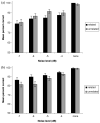Native-language benefit for understanding speech-in-noise: The contribution of semantics
- PMID: 21151815
- PMCID: PMC2999832
- DOI: 10.1017/S1366728909990150
Native-language benefit for understanding speech-in-noise: The contribution of semantics
Abstract
Bilinguals are better able to perceive speech-in-noise in their native compared to their non-native language. This benefit is thought to be due to greater use of higher-level, linguistic context in the native language. Previous studies showing this have used sentences and do not allow us to determine which level of language contributes to this context benefit. Here, we used a new paradigm that isolates the SEMANTIC level of speech, in both languages of bilinguals. Results revealed that in the native language, a semantically related target word facilitates the perception of a previously presented degraded prime word relative to when a semantically unrelated target follows the prime, suggesting a specific contribution of semantics to the native language context benefit. We also found the reverse in the non-native language, where there was a disadvantage of semantic coext on word recognition, suggesting that such top-down, contextual information results in semantic interference in one's second language.
Figures
Similar articles
-
Relative Weighting of Semantic and Syntactic Cues in Native and Non-Native Listeners' Recognition of English Sentences.Ear Hear. 2016 Jul-Aug;37(4):424-33. doi: 10.1097/AUD.0000000000000271. Ear Hear. 2016. PMID: 26783854
-
Second-language word recognition in noise: Interdependent neuromodulatory effects of semantic context and crosslinguistic interactions driven by word form similarity.Neuroimage. 2021 Aug 15;237:118168. doi: 10.1016/j.neuroimage.2021.118168. Epub 2021 May 15. Neuroimage. 2021. PMID: 34000398
-
Bilingual speech-in-noise: neural bases of semantic context use in the native language.Brain Lang. 2014 May;132:1-6. doi: 10.1016/j.bandl.2014.01.009. Epub 2014 Mar 3. Brain Lang. 2014. PMID: 24594855
-
Semantic versus perceptual interactions in neural processing of speech-in-noise.Neuroimage. 2013 Oct 1;79:52-61. doi: 10.1016/j.neuroimage.2013.04.049. Epub 2013 Apr 23. Neuroimage. 2013. PMID: 23624171
-
Bilinguals Show Proportionally Greater Benefit From Visual Speech Cues and Sentence Context in Their Second Compared to Their First Language.Ear Hear. 2022 Jul-Aug 01;43(4):1316-1326. doi: 10.1097/AUD.0000000000001182. Epub 2021 Dec 23. Ear Hear. 2022. PMID: 34966162
Cited by
-
Neural Correlates of Early Sound Encoding and their Relationship to Speech-in-Noise Perception.Front Neurosci. 2017 Aug 25;11:479. doi: 10.3389/fnins.2017.00479. eCollection 2017. Front Neurosci. 2017. PMID: 28890684 Free PMC article.
-
Non-native Listeners Benefit Less from Gestures and Visible Speech than Native Listeners During Degraded Speech Comprehension.Lang Speech. 2020 Jun;63(2):209-220. doi: 10.1177/0023830919831311. Epub 2019 Feb 22. Lang Speech. 2020. PMID: 30795715 Free PMC article. Clinical Trial.
-
Purposeful listening in challenging conditions: A study of prediction during consecutive interpreting in noise.PLoS One. 2023 Jul 20;18(7):e0288960. doi: 10.1371/journal.pone.0288960. eCollection 2023. PLoS One. 2023. PMID: 37471379 Free PMC article.
-
Exploring the role of singing, semantics, and amusia screening in speech-in-noise perception in musicians and non-musicians.Cogn Process. 2024 Feb;25(1):147-161. doi: 10.1007/s10339-023-01165-x. Epub 2023 Oct 18. Cogn Process. 2024. PMID: 37851154 Free PMC article.
-
Decoding of Envelope vs. Fundamental Frequency During Complex Auditory Stream Segregation.Neurobiol Lang (Camb). 2020 Jul 1;1(3):268-287. doi: 10.1162/nol_a_00013. eCollection 2020. Neurobiol Lang (Camb). 2020. PMID: 37215227 Free PMC article.
References
-
- Andruski JE, Blumstein SE, Burton M. The effect of subphonetic differences on lexical access. Cognition. 1994;52(3):163–187. - PubMed
-
- Balota DA, Yap MJ, Cortese MJ, Hutchison KA, Kessler B, Loftis B, Neely DL, Nelson DL, Simpson GB, Treiman R. The English Lexicon Project. Behavioral Research Methods. 2007;39(3):445–459. - PubMed
-
- Bernstein IH, Bissonnette V, Vyas A, Barclay P. Semantic priming: Subliminal perception or context? Perception & Psychophysics. 1989;45(2):153–161. - PubMed
-
- Bilger RC, Nuetzel JM, Rabinowitz WM, Rzeczkowski C. Standardization of a test of speech perception in noise. Journal of Speech and Hearing Research. 1984;27(1):32–48. - PubMed
-
- Boothroyd A, Mulhearn B, Gong J, Ostroff J. Effects of spectral smearing on phoneme and word recognition. Journal of the Acoustical Society of America. 1996;100(3):1807–1818. - PubMed
Grants and funding
LinkOut - more resources
Full Text Sources


